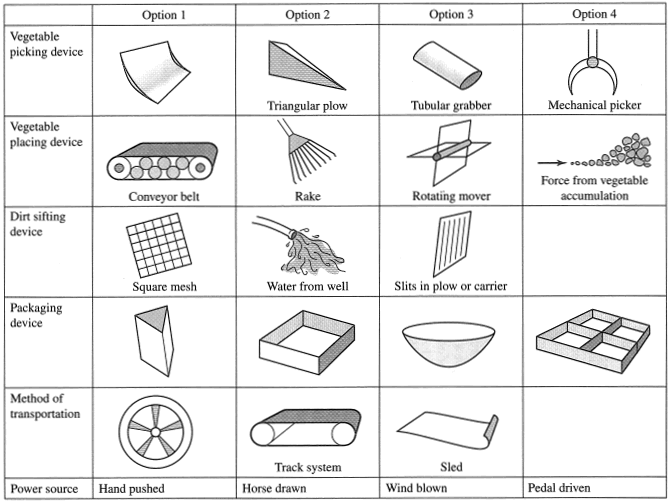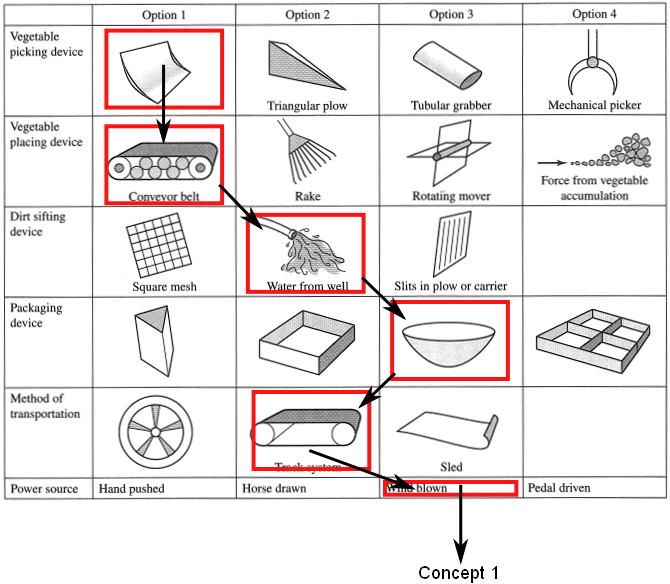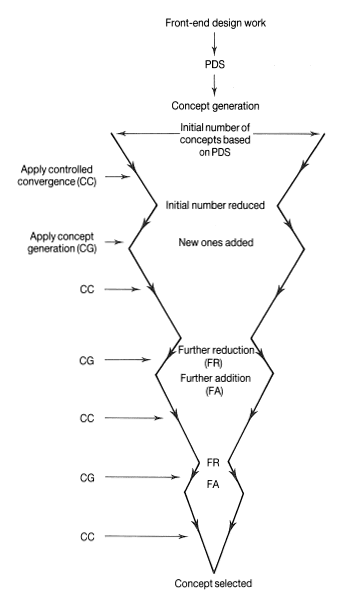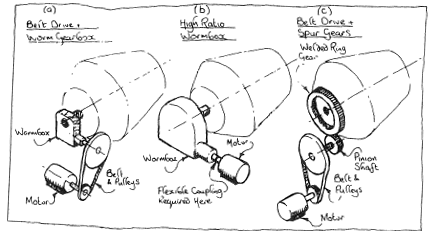Morphological Analysis
“An idea is nothing more nor less than a new combination of old elements.” (Foster 2007: 13).
This technique will help establish the essential systems and incorporate them into the product (Cross 2009: 137) by collating them into a single matrix so you can see all of you ideas together. You should try to reduce the number of generated ideas from the lateral thinking diagram into those that really are the most suitable. This will help to start to build an idea of the various systems that will combine to make your final product. The final novel idea, does not simply materialise but develops from many smaller spontaneous thoughts (Cross 2009: 137).
Figure 1 depicts a morphological chart for a vegetable collection system, continued from the Lateral Thinking Model above. See how the Generated Alternatives from before have now been formed into a matrix with images to help explain further. These sketches don’t have to be Monet, but they do need to clearly describe the product. You would then pick a path through them to begin design Concept number 1, as Figure 2 suggests.

Figure 1 – Morphological Analysis for a vegetable collection system (Haik and Shahin 2011:175 )

Figure 2 – Morphological Analysis for vegetable collection system with selections (Haik and Shahin 2011: 175)
You are NOW at a stage to begin concept design.
Your first few concept designs should follow different routes through the Morphological Matrix, that is why you have compiled it. Do not ignore it. In this instance;
Concept 1 could be – scoop > conveyor belt > water from well > bowl > track system > wind blown
Concept 2 could be – triangular plow > rotating mover > water from well > wheel > hand push
Concept 3 could be – scoop > conveyor belt > square mesh > wheel > hand push
Once you begin to combine these ideas, you’ll gain momentum and start to generate lots of ideas, organise your thoughts, change, erase, scrap, retrieve from bin, enthuse, destroy and generally go through the generation process. The image below is a very good example of how you might sketch a number of alternatives to investigate different concepts.
ALWAYS ANNOTATE YOUR SKETCHES. It makes it easier for you to describe the process and easier for us to mark. This work should go in your logbook and eventually be scanned into the appendix.
It’s generally accepted that you should produce at least three well-considered concepts, annotated and developed to a level that is distinguishable as an acceptable solution. You will decide upon a Final Concept using Pugh’s Matrix at the next step. Always keep in mind the PDS and QFD you formed and constantly check back to ensure you’re keeping with the guidelines. The diagram in Figure 3 represents how your ideas may begin to narrow as you develop your ideas.

Figure 3 – Flexible Design Model (Pugh 1991: 75)

Figure 4 – Excellent example of application of concept design using morphological analysis to generate layouts (Cross 2009: 32)
Back to Sketching, Brainstorming Ideas and Morphological Analysis
Back to Concept Design
Back to MAE Design Model